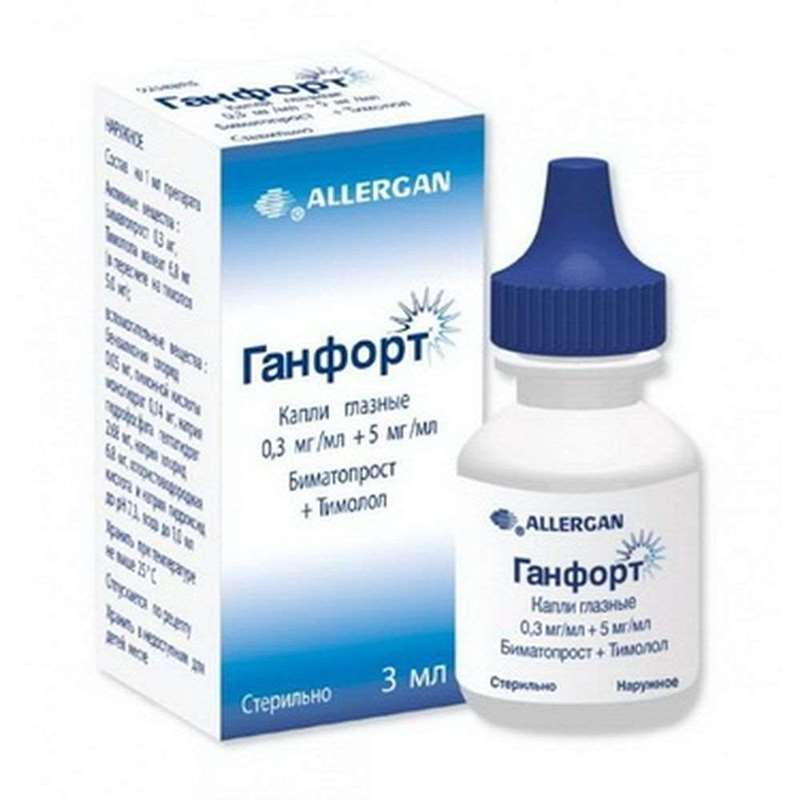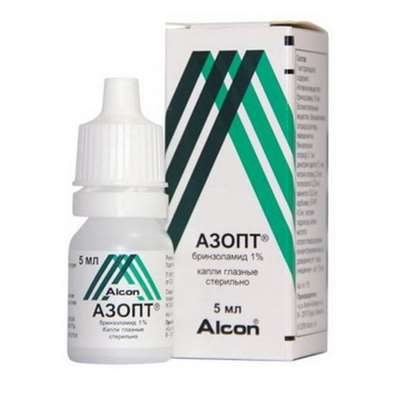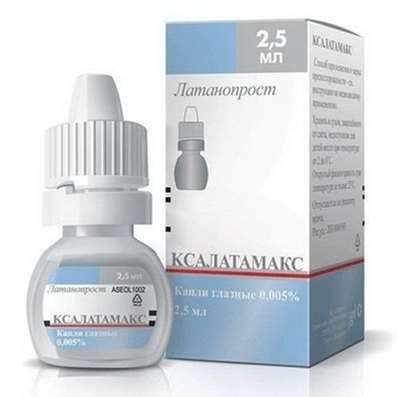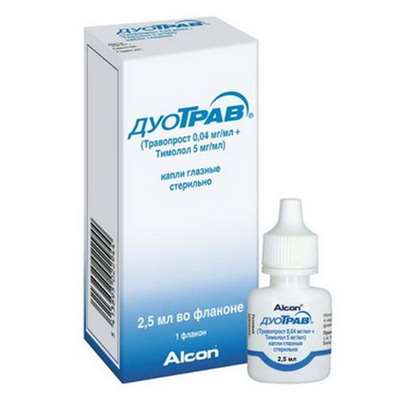Ganfort eye drops - is an ophthalmic preparation for topical application. Combined anti-glaucomatous agent, miotic, beta-blocker.
Ganfort is a combined drug, its constituent bimatoprost and timolol reduce intraocular pressure (IOP) due to the combined interaction, leading to a much more pronounced hypotensive affect compared to the effect of each of the components alone.
Bimatoprost
Refers to synthetic proteams, chemical structure similar to prostaglandin F2α (PGF2α). Bimatoprost has no effect on any of the known types of prostaglandin receptors. The hypotensive effect of bimatoprost is due to increased outflow of intraocular fluid through the trabeculae and the uveoscleral pathway of the eye.
Timolol
Non-selective beta-blocker, does not have internal sympathomimetic and membrane-stabilizing activity.
Timolol reduces IOP by reducing the formation of intraocular fluid. The exact mechanism of action is not established, it may be associated with inhibition of the synthesis of cyclic adenosine monophosphate (c-AMP) and is caused by endogenous stimulation of beta-adrenergic receptors.
Pharmacokinetics
Systemic absorption of the drug is minimal, it does not differ either with combined treatment or with instillation of each component of the drug separately.
In two studies of 12 months duration, no systemic cumulation of any of the active substances was noted.
Bimatoprost
In vitro studies have shown that bimatoprost penetrates the iris and sclera. When instillating 0.03% bimatoprosta solution 1 drop in both eyes once a day for 2 weeks, the maximum concentration (C max) of bimatoprost in blood plasma is reached within 10 minutes after application, and for 1.5 hours its concentration in the blood plasma is reduced to the lower limit of detection (0.025 ng / ml). The mean C max and the area under the concentration-time curve (AUC 0-24 h) of bimatoprost were close on days 7 and 14, and were 0.08 ng / ml and 0.09 ng * h / ml, respectively, indicating to the fact that the equilibrium concentration of bimatoprost is reached during the first week of use.
Bimatoprost is moderately distributed in tissues, and the systemic volume of distribution when the equilibrium concentration of the drug is reached is 0.67 l / kg. Bimatoprost is mainly in the blood plasma. The association of bimatoprost with plasma proteins is approximately 88%. Bimatoprost is subjected to oxidation, N-deethylation and glucuronation with the formation of various metabolites.
Bimatoprost is excreted mainly by the kidneys. About 67% of the drug, injected intravenously to healthy volunteers, was excreted in the urine, and 25% - through the gastrointestinal tract. The half-life (T 1/2) of bimatoprost, determined after its intravenous administration, was approximately 45 minutes; and the total ground clearance is -1.5 l / h / kg.
Pharmacokinetics in special clinical cases
In elderly patients
Using bimatoprost 2 times a day, the average AUC value of 0-24 h in elderly patients is 0.0634 ng * h / ml, which significantly exceeds the value of this parameter in healthy young people - 0.0218 ng * h / ml.
Nevertheless, this difference is not of clinical importance, since the systemic exposure of bimatoprost in its local application in elderly patients and healthy young people remains very low. Cumulation of bimatoprost in the systemic circulation is not observed, the safety profile is not different in elderly patients and young people.
Timolol
In patients who underwent cataract surgery, after instillation of eye drops in the form of a 0.5% solution, C max timolol in the intraocular fluid after 1 h was 898 ng / ml. Some of the drug enters the systemic circulation, and is metabolized in the liver. T 1/2 of timolol is about 4-6 hours. A part of timolol, subjected to metabolism in the liver, is excreted through the gastrointestinal tract, and the other part and metabolites are excreted by the kidneys.
Timolol binds to a small extent with the proteins of the blood plasma.
Indications:
Decrease in intraocular pressure (IOP) in patients with open-angle glaucoma and intraocular hypertension with insufficient effectiveness of topical application of beta-adrenoblockers and prostaglandin analogues.
Contraindications:
- Hypersensitivity to the components of the drug.
- Syndrome of increased reactivity of the respiratory tract, including bronchial asthma in the stages of exacerbation and past episodes in the anamnesis.
- Severe chronic obstructive pulmonary disease (COPD).
- Sinus bradycardia.
- Atrioventricular blockade of II and III degree.
- Clinically expressed heart failure.
- Cardiogenic shock.
- Age to 18 years.
- Pregnancy.
- The period of breastfeeding.
Carefully:
- Dysfunction of the liver and kidneys (the drug is not sufficiently studied in this category of patients).
- In patients with risk factors for edema of the macula (for example, with aphakia, pseudophakia, lens rupture).
- In patients with diabetes mellitus (unstable flow) and impaired glucose tolerance, because the gumfort beta-adrenoblocker Timolol, which is part of the preparation, can mask signs of hypoglycemia.
- In patients with inflammatory changes in the eyes, neovascular, inflammatory, occlusive glaucoma, congenital glaucoma or narrow-angle glaucoma (no data on efficacy and safety).
Special instructions:
Just like other ophthalmic drugs, Ganfort can penetrate into the systemic bloodstream.
Symptoms of heart failure should be compensated before the use of the drug Ganfort. It is necessary to regularly monitor the condition of patients with severe heart failure, the definition of heart rate "." When using timolol, there were reports of side effects from the cardiovascular system and respiratory organs, including deaths due to bronchospasm in patients with bronchial asthma, and also less often from heart failure.
Beta-adrenoblockers can mask symptoms of hypoglycemia, hyperthyroidism and cause a worsening of Prinzmetal angina pectoris, severe peripheral and central vascular disorders, and hypotension.
In patients with atopic manifestations in the anamnesis and severe anaphylactic reactions to various allergens, the doses of epinephrine (adrenaline), which are usually used to arrest anaphylactic reactions, against the background of the use of beta-blockers may be ineffective.
In patients with hepatic liver disease or initially elevated activity of liver enzymes-alanine aminotransferase (ALT), aspartate aminotransferase (ACT) and / or total bilirubin, bimatoprost did not affect liver function during the study period of more than 24 months.
Before starting treatment, patients should be informed about possible eyelash growth, pigmentation of the eyelid skin and iris pigmentation, as these side effects are established in the studies of bimatoprost and Gunfort. Some changes can be permanent, and may be accompanied by the appearance of a difference between the eyes, if the instillations of the drug were carried out only in one eye. After the cannabis preparation is canceled, the pigmentation of the iris may remain constant. After 12 months of treatment with Gunforth, the frequency of iris pigmentation was noted in 0.2% of patients. And after 12 months of treatment, only bimatoprostom in the form of eye drops 1.5%, further increase in the frequency of this effect was not observed during therapy duration of 3 years. The increase in pigmentation of the iris is due to the increased production of melanocytes, and not simply by the increase in their number.
The benzalkonium chloride supplement, which is part of the Ganfort preparation, can cause irritation of the mucous membrane of the eyes and changes in the color of soft contact lenses. Contact lenses must be removed before the drug is administered, they can be dressed 15 minutes after instillation.
Benzalkonium chloride can cause acute keratitis and / or toxic corneal ulcer. In this regard, it is necessary to monitor the patient's condition with frequent or prolonged treatment with Ganforth in individuals with dry eye syndrome and with corneal changes.
After opening the vial, it is impossible to exclude the possibility of microbial contamination of its contents, which can lead to inflammatory lesions of the eyes. The shelf life of the drug after the first opening of the bottle is 28 days. After the expiration of the specified time, the vial should be discarded, even if the solution is not completely used. It is recommended to record on the cardboard pack of the drug the date of opening the vial.
Impact on the ability to manage vehicles and mechanisms
There may be a transient visual impairment after the administration of the drug, so the patient must wait until the vision is fully restored before proceeding to driving the car or controlling the mechanisms.
Suggested Use:
Recommended doses in adults (including elderly patients): 1 drop is instilled in the conjunctival sac of the affected eye 1 time per day in the morning.
If the administration of the drug is missed once, the drug is administered the next day. Do not exceed the dose of 1 injection once a day. If more than 2 drugs are used, it is necessary to take a 5-minute break between each instillation.
Packaging:
- Comes in original packaging. Item is brand new and unopened.
Storage:
- Keep away from direct sunlight.
- Keep locked and away from children.
- Store in dry place at room temperature.
- Do not exceed storage temperature higher than 25 C
Important notice- the outer box design may vary before prior notice!

 Cart
Cart





